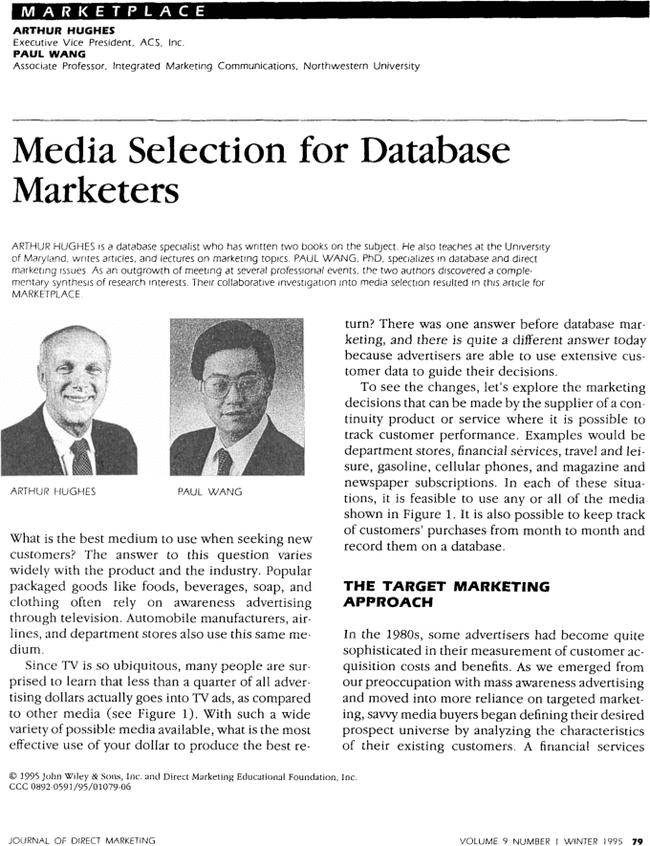Media selection for database marketers
引用次数: 29
Abstract
1. GENERAL PLANNING STRATEGY MAINTAINING RELATIONSHIPS WITH CUSTOMERS: SOME CRITICAL FACTORS Martin, Mary C. and Ravipreet S. Sohi (1993), En· hancing Knowledge Development in Marketing: 1993 AMA Educators' Proceedings, 4 (Summer conference), pp. 21-27. Through exploratory interviews with sellers, the authors build on theoretical conceptualizations of determinants of relationship continuance. They propose that within the domain of the buyer-seller intersection, trust, frequency, and quality of com· munication, and relational norms support the con· tinuance of relationships. Customer orienlation, likeability, competence, and dependability are im· portant seller characteristics for relationship continuity. Finally, environmental uncertainty supports the continuance of buyer-seller relationships. Babin. (4,5) CAN THIS RELATIONSHIP WORK? Arthur M. Hughes (1994), Marketing Tools, 1 (July/ August), pp. 4-11. How do you know when database marketing works and when it doesn't? Relationship marketing works if the following is true: The provider has a well thought·out program; the payment system makes obtaining names, addresses, and purchase behavior easy; the product involves repeat purchases with name capture; there is an affinity group with which to construct a database; and a frequency reward sys· tern can be constructed. On the other hand, two attributes signal trouble for database marketing: The product is a commodity with too small a markup to finance relationship marketing efforts and the pur· chase is made seldom and unpredictably. To illus· trate how the decision to develop a relationship marketing program can be made, the author has de· veloped a customer lifetime value model utilizing retention rate spending rate and net present value to determine a lifetime value. Utilizing this model, projections can be made predicting the elfects of a relationship marketing program. The examples shown include vacuum cleaners (for which relationship marketing wouldn't work) and a chain of upscale women's fashion shops (for which it would). Carner. (9, 14) CUSTOMER LOYALTY, TOWARD AN INTEGRATED CONCEPTUAL FRAMEWORK Alan Dick and Kunai Basu (1994), journal of the Academy of M""keting Science, 22 (Spring), pp. 99-113. The authors present a conceptual framework to un· derstand the attitudinal components of customer loyalty and its consequences. The relative strength of rhe relationship compared to competing olferings is a key factor. Other factors would be identifying the important antecedents such as the cognitive, in· formational determinants or brand beliefs; the alfect of feeling states such as emotions; and the conative state relating to behavioral aspects such as switching costs, expectations, and sunk costs. The framework also suggests the importance of social norms and situational factors such as store incentives and promotions. Implications for research and how man· agers might improve store loyalty after using this framework are olfered. Sherman. (14) 3. CREATIVITY, IDEA GENERATION PROMOTIONAL STRATEGIES TO ENHANCE CHARITABLE BEHAVIOR: AN INTERACTIONAL FRAMEWORK Neeli Bendapudi and Smendra N. Singh (1993), American Academy ofAdvertising Proceedings, pp. 208-215. This article reviews marketing, advertising, and psychology literature to develop 14 communication hypotheses designed to proVide managers of non· profit organizations with practical, actionable gUidelines for developing more elfective messages and solicitation appeals. Nonprofit direct marketers will find recommendations regarding message e 1995 John Wiley & Sons, Inc. :lnd Dirct.'1 MarkctinR Educational Foundation, Inc. CCC 0892·0591/95/01085·04 JOURNAL OF DIRECT MARKETING VOLUME 9 NUMBER 1 WINTER 1995 as

数据库营销人员的媒介选择
1. Martin, Mary C.和Ravipreet S. Sohi (1993), En·提高市场营销中的知识发展:1993年美国医学会教育工作者会议论文集,第4期(夏季会议),第21-27页。通过与卖家的探索性访谈,作者建立了关系延续决定因素的理论概念化。他们提出,在买卖双方交集的领域内,信任、交流的频率和质量以及关系规范支持关系的持续。顾客导向、亲和力、能力和可靠性是维系关系的重要卖家特征。最后,环境的不确定性支持了买卖双方关系的延续。Babin。(4,5)这种关系能起作用吗?Arthur M. Hughes (1994), Marketing Tools, 1(7 / 8月),pp. 4-11。您如何知道数据库营销何时起作用,何时不起作用?如果满足以下条件,关系营销是有效的:供应商有一个深思熟虑的计划;支付系统使获取姓名、地址和购买行为变得容易;该产品涉及重复购买与名称捕获;有一个用于构建数据库的亲和组;并可构造频率奖励项。另一方面,数据库营销有两个问题:产品是一种商品,利润太小,无法为关系营销提供资金;追求很少,而且不可预测。为了说明如何制定关系营销计划的决策,作者开发了一个客户终身价值模型,利用保留率、消费率和净现值来确定终身价值。利用这个模型,可以对关系营销计划的效果进行预测。所展示的例子包括真空吸尘器(关系营销对其无效)和高档女装时装连锁店(关系营销对其有效)。肉欲。(9, 14)“顾客忠诚:一个整合的概念框架”,《管理科学学报》,1994年第22期,第99-113页。作者提出了一个概念性框架来理解顾客忠诚的态度成分及其后果。与竞争对手相比,这种关系的相对强度是一个关键因素。其他因素包括识别重要的前因由,如认知、形成决定因素或品牌信念;情绪:感觉状态的影响,如情绪;以及与行为方面有关的自然状态,如转换成本、期望和沉没成本。该框架还表明社会规范和情境因素(如商店激励和促销)的重要性。对研究的影响以及管理者如何在使用该框架后提高商店忠诚度。谢尔曼。(14) 3。李建平(1993),《中国社会科学》,第1期,第1 -2页。本文回顾了市场营销、广告和心理学文献,提出了14个沟通假设,旨在为非营利组织的管理者提供实用的、可操作的指导方针,以开发更有效的信息和募捐呼吁。非营利性的直接营销人员将找到有关信息的建议。1995年约翰威利父子公司:土地直接。1 MarkctinR教育基金会股份有限公司直销杂志1995年冬季第9卷第1期
本文章由计算机程序翻译,如有差异,请以英文原文为准。
求助全文
约1分钟内获得全文
求助全文

 求助内容:
求助内容: 应助结果提醒方式:
应助结果提醒方式:


